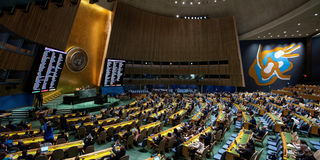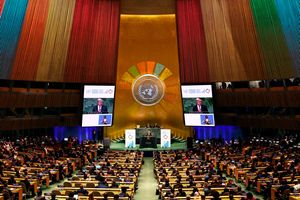At the UN, African leaders call for specific funding for women’s health

The United Nations General Assembly votes at the United Nations headquarters in New York City, US, May 23, 2024.
African leaders are calling on donors and development investors to fund, and develop, an agenda specifically targeting the health of women, children, and adolescents.
President William Ruto, speaking at a high-level event on securing the health and well-being of every woman, child and adolescent, said that funding for specified programmes could help countries on the continent achieve goals in the Sustainable Development Goals (SDG).
Ruto spoke at the event on the need for political leadership to achieve the 2030 Sustainable Development Goals, the UN targets meant to see the world a better place to live in with fewer conflicts, healthier communities and better economies, by 2030.
Yet African countries have often been pummeled by health hazards including Covid-19, Ebola and Mpox, all of which have also hurt special demographics like women and children.
In Kenya, Ruto said on Wednesday the country has made considerable progress in reducing child and maternal deaths, challenges such as funding and inadequate limited capacity to provide essential services persist.
“We have pledged to enhance partnership and establish a dedicated fund for maternal and child health to expand the delivery of essential services care to the mothers. Countries must recognise that only urgent collective action can save millions of lives by 2030,” Dr Ruto said.
“Keeping people healthy is beneficial and studies have shown that every dollar spent on maternal and child health yields $9 in return through health and productivity.
Any annual investment of $ 1.5 billion could save 35 million lives by 2030 and generate $100 billion in productivity and healthcare savings.
“We have a singular opportunity to escalate our contributions to global health initiatives and significantly enhance their impact by supporting Africa health strategy as a campaign to accelerate the reduction of maternal and newborn mortality in Africa as an ideal starting point,” he said.
Return on investment
Ruto said the return on investment in adolescents’ health is estimated at between $5 and $10 spent with school-based and community-targeted intervention being highly effective.
In Kenya, we are deploying community health promoters to bring vital information directly to communities as part of our commitment to a sustainable and equitable future by securing the health and well-being of women, children and adolescents.
“We have had a robust conversation in Kenya, Linda Mama, which ensured that the government of Kenya pays for the prenatal and postnatal services of all the expectant mothers in the country. We have since under our new Universal Health Programme expanded to include the child up to five years so that we can take care of vulnerable children,”
“We have also expanded Eduafya to include all the secondary going children until the age of 18 years. So that all adolescents benefit from a government-paying programme.
He said only a multisectoral approach including health care education and community support can accelerate mortality reduction. Back home, however, some of the health insurance programmes have seen his government forced into more taxation of the public to fund them. The new Social Health Insurance Fund to begin in October will be funded from a percentage of deductions from taxpayers who had previously gone to court to try and stop it.
Kenya is one of the top five countries in Africa with the highest number of pregnant women who die as a result of complications from pregnancy or childbirth.
According to a United States Agency for International Development (Usaid) report on Preventing Child and Maternal Deaths in 2024, Kenya ranks fourth with 594 deaths per 100,000 live births, which puts the country off track to meet the United Nations Sustainable Development Goal (SDG) target number three.
The global maternal mortality target for 2030 is to reduce the average maternal mortality ratio to less than 70 deaths per 100,000 live births, with no country exceeding a maternal mortality ratio of 140 deaths per 100,000 live births.
However, each country has its national targets for 2030, depending on whether its 2010 baseline maternal mortality ratio (MMR) was below or above 420. If below 420, its target is to reduce the MMR by at least two-thirds by 2030; if above or equal to 420, its target is to achieve an MMR of 140 or less by 2030.
"Since 2000, remarkable progress has been made on maternal mortality, with a 42 percent reduction in USAID's 25 priority countries. While Kenya has made significant progress in reducing maternal mortality, it still falls short of the World Health Organisation (WHO) target," the report stated
According to the Ministry of Health, Kenya's maternal mortality rate remains a major public health concern, with 15 out of 47 counties accounting for 98.7 percent of all maternal deaths.
These high-burden counties face a range of challenges including poverty, insecurity, inadequate infrastructure and historical marginalisation, which have led to poor maternal and newborn health outcomes.
South African President Cyril Ramaphosa echoed Ruto's sentiments by calling on global leaders to protect the rights of vulnerable populations including mothers and children and present evidence that demonstrate a reduction in mortality and morbidity.
“We have to seriously take women's and children's health in all the programmes that they do.
“Countries across the world to work together to meet the financing target for organisations that support women, children and adolescents including the global financing facilities, Unicef and United Nations Populations Fund (UNFPA),” Mr Rammaphosa said.
He called on stakeholders in the women, children and adolescents health sector to target countries with highest with highest maternal and infant mortality rates to reduce the numbers.
Mr Kassim Majaliwa, Tanzania's prime Minister said the continent must secure the health of children and women to be assured of a healthier humanity.
“This situation compels us to prioritise a better future for every child. We need to agree on actions to accelerate progress in women, children and adolescents’ health,” he said.
Sustainable funding, he said, is critical adding that sharing data and focusing on best practices will enhance the continent's collective efforts.
A recent report released last week by the UN Women revealed a concerning lack of progress in achieving gender equality indicating that the world has failed women falling short of its commitments to women and girls.
As the world approaches the 2030 deadline for the Sustainable Development Goals (SDGs), the report released at the 79th United Nations General Assembly highlights that not a single indicator under Goal 5 (gender equality) has been fully achieved.





